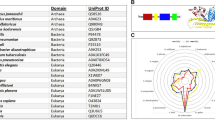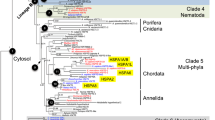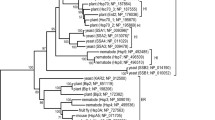Abstract
The eukaryotic cyto-/nucleoplasmatic 70-kDa heat-shock protein (HSP70) has homologues in the endoplasmic reticulum as well as in bacteria, mitochondria, and plastids. We selected a representative subset from the large number of sequenced stress-70 family members which covers all known branches of the protein family and calculated and manually improved an alignment. Here we present the consensus sequence of the aligned proteins and putative nuclear localization signals (NLS) in the eukaryotic HSP70 homologues. The phylogenetic relationships of the stress-70 group family members were estimated by use of different computation methods. We present a phylogenetic tree containing all known stress-70 subfamilies and demonstrate the usefulness of stress-70 protein sequences for the estimation of intertaxonic phylogeny.
Similar content being viewed by others
References
Agranovsky AA, Boyko VP, Karasev AV, Koonin EV, Dolja VV (1991) Putative 65kDa protein of Beet Yellows Closterovirus is a homologue of HSP70 heat shock proteins. J Mol Biol 217:603–610
Ausubel FM (ed) (1989) Current protocols in molecular biology. J Wiley & Sons, Brooklyn, appendix 1, supplement 12
Bairoch A (1992) PROSITE: a dictionary of sites and patterns in proteins. Nucleic Acids Res 20:2013–2018
Bardwell JCA, Craig EA (1984) Major heat shock gene of Drosophila and the Escherichia coli heat-inducible dnaK gene are homologous. Proc Natl Acad Sci USA 81:848–852
Bienz M (1984) Xenopus hsp70 genes are constitutively expressed in injected oocytes. EMBO J 3:2477–2483
Boorstein WR, Craig EA (1990) Structure and regulation of the SSA4 HSP70 gene of Saccharomyces cerevisiae. J Biol Chem 265: 18912–18921
Chitnis PR, Nelson N (1991) Molecular cloning of the genes encoding two chaperone proteins of the cyanobacterium Synechocystis sp. PCC6803. J Biol Chem 266:58–65
Craig EA, Jacobsen K (1985) Mutations in cognate genes of Saccharomyces cerevisiae hsp70 result in reduced growth rate at low temperatures. Mol Cell Biol 5:3517–3524
Craig EA (1989) SSC1, an essential member of the yeast HSP70 multigene family, encodes a mitochondrial protein. Mol Cell Biol 5:3517–3524
Craig EA, Kramer J, Shilling J, Werner-Washburne M, Holmes S, Kosic-Smithers J, Nicolet JM (1989) SSC1, an essential member of the yeast HSP70 multigene family, encodes a mitochondrial protein. Mol Cell Biol 9:3000–3008
Dingwall C, Laskey RA (1991) Nuclear targeting sequences—a consensus? Trends Biochem Sci 16:478–481
Dworniczak B, Mirault ME (1987) Structure and expression of a human gene coding for a 71kDa heat shock ‘cognate’ protein. Nucleic Acids Res 15:5181–5197
Engman DM, Sias SR, Gabe JD, Donelson JE, Dragon EA (1989) Comparison of hsp70 genes from two strains of Trypanosoma cruzi. Mol Biochem Parasitol 37:285–288
Engman DM, Fehr SC, Donelson JE (1992) Specific functional domains of mitochondrial HSP70s suggested by sequence comparison of the trypanosome and yeast proteins. Mol Biochem Parasitol 51:153–155
Felsenstein J (1985) Confidence limits on phylogenies: an approach using the bootstrap. Evolution 39:783–791
Felsenstein J (1988) Phylogenies from molecular sequences: inference and reliability. Annu Rev Genet 22:521–565
Felsenstein J (1989) PHYLIP—phylogeny inference package (version 3.2). Cladistics 5:164–166
Friedman DI, Olson ER, Georgopoulos C, Tilly K, Herskowitz I, Banuett F (1984) Interactions of bacteriophage and host macromolecules in the growth of bacteriophage λ. Microbiol Rev 48: 299–325
Georgopoulos C (1992) The emergence of the chaperone machines. Trends Biochem Sci 17:295–299
Gething M-J, Sambrook J (1992) Protein folding in the cell. Nature 355:33–45
Giebel LB, Dworniczak BP, Bautz EK (1988) Developmental regulation of a constitutively expressed mouse mRNA encoding a 72-kDa heat shock-like protein. Dev Biol 125:200–207
Gomes SL, Gober JW, Shapiro L (1990) Expression of the Caulobacter heat shock gene dnaK is developmentally controlled during growth at normal temperatures. J Bacteriol 172:3051–3059
Gray MW (1992) The endosymbiont hypothesis revisited. Int Rev Cytol 141:233–357
Griess EA, Reusing SA, Grasser KD, Maier U-G, Feix G (1993) Phylogenetic relationships of HMG box DNA-binding domains. J Mol Evol 37:204–210
Higgins DG, Bleasby AJ, Fuchs R (1992) CLUSTAL V: improved software for multiple sequence alignment. CABIOS 8:189–191
Hofmann CJB, Rensing SA, Häuber MM, Martin WF, Müller SB, Couch J, McFadden GI, Igloi GL, Maier U-G (1994) Smallest known eukaryotic genomes encode a protein gene: towards an understanding of nucleomorph functions. Mol Gen Genet (in press)
Hughes AL (1993) Nonlinear relationships among evolutionary rates identify regions of functional divergence in Heat-Shock Protein 70 genes. Mol Biol Evol 10:243–255
Hunt C, Morimoto RI (1985) Conserved features of eukaryotic hsp70 genes revealed by comparison with the nucleotide sequence of human hsp70. Proc Natl Acad Sci USA 82:6455–6459
Kimura M (1980) A simple model for estimating evolutionary rates of base substitutions through comparative studies of nucleotide sequences. J Mol Evol 16:111–120
Kornak JM, Kuo CC, Campbell LA (1991) Sequence analysis of the gene encoding the Chlamydia pneumoniae DnaK protein homolog. Infect Immun 59:721–725
Leung KC, Rajendran MY, Monfries C, Hall C, Lim L (1990) The human heat-shock protein family. Expression of a novel heat-inducible HSP70 (HSP70B') and isolation of its cDNA and genomic DNA. Biochem J 267:125–132
Macario AJL, Dugan CB, Conway de Macario E (1991) A DnaK homologue in the archaebacterium Methanosarcina mazei. Gene 108:133–137
MacFarlane J, Blaxter ML, Bishop RP, Miles MA, Kelly JM (1990) Identification and characterization of a Leishmania donovani antigen belonging to the 70-kDa heat-shock protein family. Eur J Biochem 190:377–384
Maerz M, Rensing S, Igloi GL, Maier U-G (1992) Evolutionary analysis of the plastid-encoded gene for the a subunit of the DNA-dependent RNA polymerase of Pyrenomonas salina (Cryptophyceae). Curr Genet 22:479–482
Maier U-G (1992) The four genomes of the alga Pyrenomonas salina (Cryptophyta). Biosystems 28:69–73
Marshall JS, Keegstra K (1992) Isolation and characterization of a cDNA encoding the major HSP70 of the pea chloroplastic stroma. Plant Physiol 100:1048–1054
Milarski KL, Morimoto RI (1989) Mutational analysis of the human HSP70 protein: Distinct domains for nucleolar localization and adenosine triphosphate binding. J Cell Biol 109:1947–1962
Morimoto RI (1993) Chaperoning the nascent polypeptide chain. Curr Biol 3:101–102
Müller FW, Igloi GL, Beck CF (1992) Structure of a gene encoding heat shock protein HSP70 from the unicellular alga Chlamydomonas reinhardtii. Gene 111:165–173
Munro S, Pelham HRB (1986) An HSP70-like protein in the ER: Identity with the 78kd glucose-regulated protein and immunoglobulin heavy chain binding protein. Cell 46:291–300
Nicholson RC, Williams DB, Moran LA (1990) An essential member of the HSP70 gene family of Saccharomyces cerevisiae is homologous to immunoglobulin heavy chain binding protein. Proc Natl Acad Sci USA 87:1159–1163
Perkins LA, Doctor JS, Zhang K, Stinson L, Perrimon N, Craig EA (1990) Molecular and developmental characterization of the heat shock cognate 4 gene of Drosophila melanogaster. Mol Cell Biol 10:3232–3238
Roberts JK, Key JL (1991) Isolation and characterization of a Soybean hsp70 gene. Plant Mol Biol 16:671–683
Rochester DE, Winer JA, Shah DM (1986) The structure and expression of maize genes encoding the major heat shock protein, HSP70. EMBO J 5:451–458
Rzhetsky AR, Nei M (1992) A simple method for estimating and testing minimum-evolution trees. Mol Biol Evol 9:945–967
Saitou N, Nei M (1987) The neighbor-joining method: a new method for reconstructing phylogenetic trees. Mol Biol Evol 4:406–425
Saitou N, Imanishi T (1989) Relative efficiencies of the Fitch-Margoliash, maximum-parsimony, maximum-likelihood, minimum-evolution, and neighbor-joining methods of phylogenetic tree construction in obtaining the correct tree. Mol Biol Evol 6: 514–525
Scaramuzzi CD, Stokes HW, Hiller RG (1992) Heat shock HSP70 protein is chloroplast-encoded in the chromophytic alga Pavlova lutherii. Plant Mol Biol 18:467–476
Schwartz RM, Dayhoff MO (1978) Matrices for detecting distant relationships. In: Dayhoff MO (ed) Atlas of protein sequence and structure 1978. The National Biomedical Research Foundation, USA, pp 353–358
Slater MR, Craig EA (1989a) The SSA1 and SSA2 genes of the yeast Saccharomyces cerevisiae. Nucleic Acids Res 17:805–806
Slater MR, Craig EA (1989b) The SSB1 heat shock cognate gene of the yeast Saccharomyces cerevisiae. Nucleic Acids Res 17:4891
Ting J, Lee AS (1988) Human gene encoding the 78000-dalton glucose-regulated protein and its pseudogene: Structure, conservation, and regulation. DNA 7:275–286
Wang S, Liu XQ (1991) The plastid genome of Cryptomonas Φ encodes an HSP70-like protein, a histone-like protein, and an acyl carrier protein. Proc Natl Acad Sci USA 88:10783–10787
Watts FZ, Walters AJ, Moore AL (1992) Characterization of PHSPl, a cDNA encoding a mitochondrial hsp70 gene from Pisum sativum. Plant Mol Biol 18:23–32
Wetzstein M, Dedio J, Schumann W (1990) Complete nucleotide sequence of Bacillus subtilis dnaK gene. Nucleic Acids Res 18:2172
Winter J, Wright R, Duck N, Gasser C, Fraley R, Shah D (1988) The inhibition of Petunia hsp70 mRNA processing during CdCl2 stress. Mol Gen Genet 211:315–319
Wu CFJ (1986) Jackknife, bootstrap and other resampling plans in regression analysis. Ann Statist 14:1261–1295
Author information
Authors and Affiliations
Additional information
Correspondence to: S.A. Reusing
Rights and permissions
About this article
Cite this article
Rensing, S.A., Maier, U.G. Phylogenetic analysis of the stress-70 protein family. J Mol Evol 39, 80–86 (1994). https://doi.org/10.1007/BF00178252
Received:
Revised:
Accepted:
Issue Date:
DOI: https://doi.org/10.1007/BF00178252




